
In today's data-driven world, the demand for high-quality, diverse datasets is ever-increasing. However, acquiring real-world data can be challenging due to privacy concerns, limited access, or expensive collection processes. This is where synthetic data comes into play. Synthetic data offers a promising solution by creating artificial datasets that mimic the characteristics of real data, enabling researchers, developers, and organizations to overcome data limitations. In this article, we will explore what synthetic data is, delve into various generation methods, and examine the diverse use cases where synthetic data can be leveraged effectively.
Understanding Synthetic Data:
Synthetic data refers to artificially generated data that replicates the statistical properties, distributions, and correlations of real-world data. It can be created using various algorithms, statistical models, or machine learning techniques. Synthetic data retains the essential features of real data without compromising individual privacy or revealing sensitive information. It provides an alternative resource for analysis, modeling, and testing, reducing the reliance on scarce or difficult-to-obtain real data.
Generation Methods:
a. Rule-Based Synthetic Data: This method involves defining explicit rules, constraints, and mathematical formulas to generate synthetic data that follow predefined patterns. It is commonly used when the underlying data has known structures or relationships, such as generating synthetic time series or simulated sensor data.
b. Model-Based Synthetic Data: Model-based approaches utilize statistical models to generate synthetic data. These models are trained on real data to learn the underlying patterns and distributions, allowing the generation of new data samples that closely resemble the original dataset. Examples include Gaussian mixture models, autoencoders, and generative adversarial networks (GANs).
c. Hybrid Approaches: Hybrid methods combine rule-based and model-based techniques to generate synthetic data. By incorporating both deterministic rules and statistical models, hybrid methods provide flexibility in generating diverse and complex datasets while maintaining specific characteristics and constraints.
Benefits of Synthetic Data:
a. Privacy Protection: Synthetic data enables organizations to protect individuals' privacy by creating datasets that contain no identifiable information. This is crucial in industries dealing with sensitive data, such as healthcare, finance, or social sciences.
b. Data Augmentation: Synthetic data can be used to expand existing datasets by generating additional samples that capture the statistical properties of the original data. This aids in enhancing the robustness and generalization of machine learning models.
c. Algorithm Development and Testing: Synthetic data allows researchers and developers to test algorithms, validate models, and fine-tune systems without the need for real-world data, which may be limited, expensive, or difficult to collect.
d. Anonymized Data Sharing: Synthetic data can facilitate the sharing of datasets for collaboration, research, or benchmarking purposes while safeguarding sensitive information. Researchers can exchange synthetic datasets without compromising privacy concerns or legal restrictions.

Use Cases for Synthetic Data:
a. Healthcare and Medical Research: Synthetic data can be utilized in medical imaging studies, patient data analysis, and clinical trial simulations. It enables researchers to generate realistic medical scenarios and conduct predictive analytics without compromising patient privacy.
b. Autonomous Vehicles and Robotics: Synthetic data aids in training autonomous vehicles and robotic systems by simulating various scenarios, road conditions, and sensor data. It enables safe and extensive testing without relying solely on real-world data, reducing costs and risks.
c. Fraud Detection and Cybersecurity: Synthetic data can be employed to simulate fraudulent activities, network intrusions, or anomalous behaviors, allowing organizations to enhance their fraud detection systems and train algorithms for cybersecurity applications.
d. Retail and Customer Analytics: Synthetic data can generate simulated customer profiles, purchasing patterns, and market trends, enabling retailers to test marketing strategies, personalize recommendations, and optimize supply chain operations.
e. Training Machine Learning Models: Synthetic data can be used to train machine learning models when the real data is scarce or subject to privacy restrictions. It aids in improving model performance, reducing bias, and achieving robustness in various domains.
5 real-time examples:
Autonomous vehicles require extensive training and testing to ensure their safety and reliability. However, collecting and labeling large amounts of real-world driving data can be challenging, time-consuming, and expensive. Synthetic data provides a valuable solution by generating virtual environments and simulated sensor data to augment real-world datasets. This enables more efficient and comprehensive testing of autonomous vehicle systems.
Here's how synthetic data is used in the context of autonomous vehicles:

1. Simulation Environment: Synthetic data is employed to create virtual environments that replicate real-world scenarios. These environments simulate various driving conditions, such as urban, rural, or highway settings, with different weather conditions, traffic patterns, and road layouts. By generating synthetic data within these environments, researchers and developers can test the performance of autonomous driving algorithms in diverse and challenging situations.

2. Sensor Simulation: Synthetic data is utilized to simulate sensor data, such as LiDAR, radar, and camera inputs. These sensors play a crucial role in perceiving the surrounding environment and making informed decisions for autonomous vehicles. By generating synthetic sensor data, developers can validate and fine-tune perception algorithms, object detection and tracking systems, and sensor fusion techniques.

3. Anomaly Testing: Synthetic data enables the simulation of rare or dangerous scenarios that are difficult to encounter in real-world testing. By introducing synthetic anomalies, such as sudden obstructions, adverse weather conditions, or unexpected pedestrian behavior, autonomous vehicle systems can be stress-tested and optimized to handle unpredictable situations more effectively.

4. Data Augmentation: Synthetic data is used to augment real-world datasets by generating additional training samples. By combining real and synthetic data, developers can expand the diversity of the training set and improve the robustness and generalization capabilities of autonomous driving models. This helps address the challenge of limited real-world data availability and ensures better performance across various driving conditions.

5. Edge Case Generation: Synthetic data assists in generating edge cases or rare events that occur infrequently in real-world driving. These edge cases involve challenging scenarios, such as extreme weather conditions, complex intersections, or unpredictable pedestrian behavior. By incorporating synthetic data representing such edge cases, autonomous vehicle systems can be trained to handle these challenging situations more effectively and safely.
Companies and research institutions involved in autonomous vehicle development, such as Waymo, Tesla, and NVIDIA, leverage synthetic data extensively to accelerate algorithm development, testing, and validation. Synthetic data allows them to simulate and evaluate a wide range of driving scenarios, thereby improving the reliability and safety of autonomous vehicles before conducting real-world tests.
By using synthetic data, autonomous vehicle developers can significantly reduce costs, speed up development cycles, and ensure more thorough testing, contributing to the advancement and adoption of autonomous driving technology.
Conclusion:
Synthetic data offers a powerful tool for overcoming data limitations, privacy concerns, and expensive data collection processes. By replicating the statistical properties of real data, synthetic data enables researchers, developers, and organizations to perform analysis, testing, and algorithm development more efficiently. With its wide range of use cases across diverse industries, synthetic data has emerged as a valuable resource in the age of big data and privacy-aware practices, opening up new possibilities for innovation and research.

